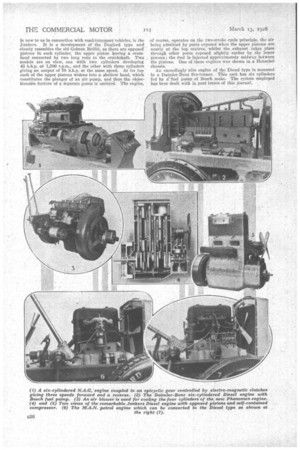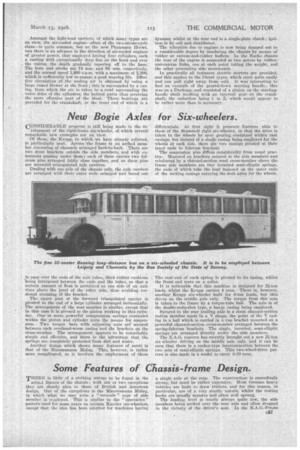Features of Engine Design.
Page 65

Page 66

Page 67

If you've noticed an error in this article please click here to report it so we can fix it.
IT is only natural that Germany—the birthplace of the
Diesel engine—should see the further development of this type of engine for commeicial vehicles, and although there. are not many concerns producing such units, yet-those which are doing so have made considerable progress. As an example of the possibilities in this direction, we think that the M.A.N. exhibits are the most striking, for amongst these were two chassis equipped with engines practically the same in dimensions and weight, one operating on, petrol and the other on heavy oil. It is possible for a vehicle user to employ the petrol type for 'town bus wic 'or; by ittere.ty.fitting different cylinder heads and substitutingjbe pumx and fueldistributing pipes and nozzles for ,th.e'e-ai-btrrettingsystem; to convert the engine to the Dieset,-plittern for fast longdistance service,' for which the heitYY.oit engine is particularly suitable. In this manner the fuel consumption is
halved and fuel at _half the price utilized, thus effecting a saving of 75 per cent.
The extra cost of the Diesel Outfit is approximately £150, but:it is claimed that, suitably employed,' this increase can. be offset ire six months, after which the running costs become 'remarkably small.
We, *ere informed by one of the directors of the M.A.N. company, Herr Maximilian Gerke, that drivers of longdistance vehicles much prefer the Diesel engine, 1.s its powerful 'pulling at low speeds enables MI ordinarY hills to be climbed; without recourse to the gearbox, thus relieving the driver from-the fatigue of gear-changing. As to fumes-from the exhaust, these depend greatly upon the quality of the oil einfdoYed, for' if the: sulphur content be high the emission of eoxious gW1 cannot_ be prevented. A particularly interesting Diesel engine, of a type:which
is new to us in connection with road-transport vehicles, is the Junkers. It is a development of the Doxford type and closely resembles the old Gobron Brilliè, as there are opposed' pistons in each cylinder, the upper piston having a crosshead connected by two long rods to the crankshaft. Two models ate on view, one with two cylinders developing 45 b.h.p. at 1,200 r.p.m., and the other with three cylinders giving an output of 70 b.h.p. at the same speed. At its top each of the upper pistons widens into a shallow head, which constitutes the plunger of an air pump, and thus the objectionable feature of a separate pump is omitted. The engine. of course, operates On the two-stroke cycle principle, the air being admitted by ports exposed when the upper pistons are nearly at the top centres, whilst the. exhaust takes place through other ports exposed slightly earlier by the lower pistons; the fuel is injected approximately midway between the pistons. One of these engines was shown in a Henschel chassis.
An exceedingly nice engine of the Diesel type is mounted in a Daimler-Bens five-tonner. This unit has six cylinders fed by trfuel pump of Bosch make. The system employed has been dealt with in past issues of this journal.
Amongst the light-load carriers, of which many types are on view, the air-cooled engine—ofteit of the two,stroke-cycle class—is quite common, but on the new Pbanomen 15-cwt. van there is an advance in the direction of air-cooled engines of greater power, that employed having four cylinders, each a casting with exceptionally deep flue on the head and over , the valves, the depth gradually tapering off to the base. The bore and stroke are 74 mm. and 90 mm. respectively, and the normal speed 1,800 r.p.m. with a maximum of 2,200, which is sufficiently low to ensure a good wearing life. Effective circulation of the cooling air is obtained by using a large vaned blower at the front ; this is surrounded by a casing, from which the air is taken to a .cowl surrounding the valve sides of the cylinders, the hottest parts thus receiving the more effective part of the blast. Three bearings are provided for the crankshaft, at the front end of which is a
dynamo, whilst at the rear end is a single-plate clutch; ignition is by coil and distributor.
The 'vibration due to engines is now being damped out to a considerable degree by insulatiug the chassis by means of rubber or canvas-and-rubber buffers. In the Nacke chassis the rear of the engine is suspended at two points by rubber, and-canvas links, one at each point taking the weight, and the other preventing side movements.
In practically all instances electric starters are provided, and this applies to the Diesel types, which start quite easily and can pull right away from .cold. It was interesting to find an example -of the geared-down starting handle ; this was on a Durkopp, and consisted of a pinion on the startinghandle shaft meshing with an internal gear on the crankshaft, the reduction being 1 to 5, which would appear to be rather more than is necessary.




























































































































